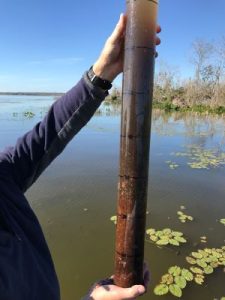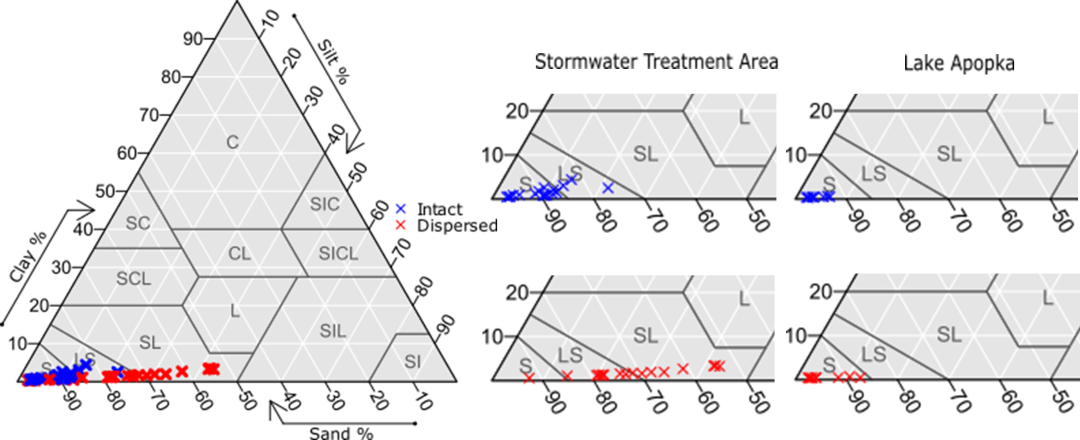A century ago, the Swedish scientist Lennart von Post devised a simple and practical way of determining the degree of decomposition of organic soil material. Known as the Von Post Scale, you take a handful of saturated soil and squeeze the water from it. Then you would examine both the water’s color and the remaining soil material, ranking it on a scale of one to ten.
Pedologists have devised several other methods for identifying the decomposition state of organic soil material during the century since von Post came up with his scale. Now, new research from the UF/IFAS Department of Soil, Water, and Ecosystem Sciences (SWES) shows precision beyond what the eye can see on its own. Using laser diffraction, scientists have evaluated the methodological parameters used to quantify the particle sizes of organic soil material in terms of microns or micrometers (1 µm = one-millionth of a meter).
“Our study shows you can measure the particle diameter of organic soil material using laser diffraction and achieve comparable certainty as you would measuring mineral (inorganic) soil material with the methods we used,” explained Daniel Colopietro, SWES doctoral candidate, whose dissertation research is the basis for the study. Dr. Allan Bacon, SWES assistant professor of environmental pedology, is his advisor.
Methods and Analysis

Teams collected 26 soil samples from sites at Lake Apopka and the Florida Everglades Stormwater Treatment Area (STA) Cell 3A North. Colopietro said they air-dried, crushed, and sieved (2mm) samples and then oven-dried and weighed them. They also took two subsamples. One to determine loss on ignition and another to determine the effect of pre-treatment on particle size distribution.
A multi-wave particle size analyzer evaluated each sample. They analyzed samples for 60 seconds in 5-minute intervals for a total of 30 minutes. The resultant light patterns (forward diffraction, backscattering, and absorption) were transformed into particle size distributions using Mie theory.
“To utilize Mie theory, the team made optical assumptions and from those assumptions created 12 optical models,” Colopietro said. “Each model has two components: the real number and the imaginary number.”
The real number is the change in the velocity of light through the tested material compared with the velocity of light in a vacuum. The imaginary number represents the transparency and absorptivity of the material. Optical properties are known for specific minerals and some organic materials; however, the imaginary number is not well known for most minerals and is non-existent for organic materials. So, the models are an attempt to constrain our optical assumptions on the heterogeneous assemblage of organic and mineral material and determine uncertainty across the particle size distribution.
Results
For the first time, they evaluated organic soil material across the entire fine earth fraction (< 2000 µm) by particle size instead of by the degree of decomposition.
“The laser diffraction estimates for the clay, silt, and sand-sized volumetric concentrations of the 26 samples varied widely,” Colopietro said. “The Lake Apopka samples were coarser with a greater volume of fibers. The Everglades STA samples also had particles greater than 50 µm, but the proportion of clay-sized particles increased four-fold compared to the Lake Apopka samples.”
The degree of decomposition played a role in the particle size distribution (PSD) of the pre-treated organic soil samples. Fibric samples showed little difference, but the sapric, or severely decomposed, samples showed a shift in the volumetric concentration from coarser to finer particles.
“A benefit of laser diffraction is the short amount of time it requires to obtain reliable particle size distributions for samples,” Colopietro explained. “We determined, that even though the mean particle diameter decreased, and the specific surface area of samples increased with increasing circulation time, indicating dispersion of particles and/or particle fragmentation, it was not statistically significant after circulating for 5 minutes.”

Implications
Organic soil material has more than 12% organic carbon by weight; however, traditional methods require the organic carbon to be removed prior to particle size analysis. This research demonstrates particle size distributions for organic soil material can be created without the removal of the organic particles.
“This is important because the size distribution of mineral particles influences various chemical, biological, hydrological, and physical processes within mineral soil material,” Colopietro said. “We can then assume that the size distribution of organic particles also influences various processes within organic soil material and now we can create a more complete picture of the distribution of particles in this material.”
You can see the full research article in the Soil Science Society of America Journal here: https://acsess.onlinelibrary.wiley.com/doi/10.1002/saj2.20588
 4
4
